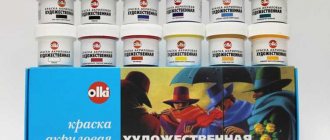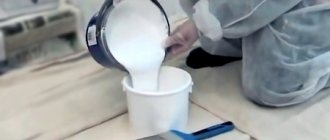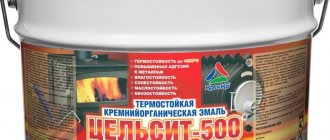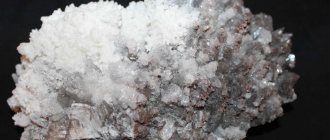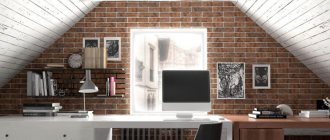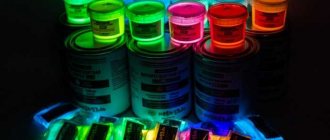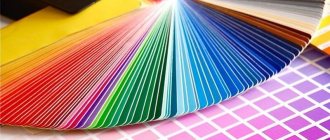Oil paints for walls are still one of the most popular materials for painting walls. This is due to its low cost and ability to protect the surface from moisture. Such paint and varnish products are made based on oils. In the past, natural ingredients were used, but now they have been replaced with synthetic drying oils and alkyds.
See our selection of photos of oil paint for indoors and outdoors.
Oil formulations
Oil compositions are used for painting internal and external surfaces of brick, plaster, wood, and metal.
The selection of oil colors is carried out basically in almost the same way as adhesive ones. Coders should be prepared from thickly ground paints, first of the color that predominates in the color scheme, then paints of other colors are gradually added to it. Thickly grated oil paints are pre-dissolved with drying oil to a working consistency. Coders are made from these workers.
Oil compositions should be in the form of thick sour cream. The paint should be applied to the surfaces to be painted in an even layer, shaded well without rough streaks or streaks. A liquid composition will flow, but a very thick composition will lay down in a thick layer and wrinkle when drying.
Thus, when selecting various paint compositions, it is necessary to achieve the desired degree of spillage or their mobility. With good mobility, traces of paint spread after some time and form a smooth coating without any streaks.
Viscosity is determined using various instruments. The simplest and most accessible is the VZ-4 viscometer (Fig. 1), which is a duralumin or plastic vessel that turns into a full cone. The upper cylindrical part has a groove for draining excess paint. The conical part ends with a stainless steel nozzle. The nozzle has a height of 4 mm, and there is a hole with a diameter of 4 mm inside it. The volume of the viscometer vessel is 100 cm3.
Before determining the viscosity, the tested paint, drying oil or other composition is heated to a temperature of 18-20° with thorough mixing of the entire mass. The viscometer should also be heated to the same temperature. Having secured the viscometer in a tripod and placed a dish under it, close the nozzle hole with your finger, pour a full vessel (100 cm3) of the composition into the viscometer, then remove your finger from the nozzle, while simultaneously turning on the stopwatch.
After the continuous flow ceases, the stopwatch is stopped. The flow time in seconds serves as an indicator of the relative viscosity.
For example, drying oil of normal viscosity flows out completely after 23-26 seconds. When prepared oil or other paints turn out to be thick, they are brought to working viscosity by thinning. Enamel paints and varnishes for mechanized painting are brought to viscosity for 35 to 40 seconds in a VZ-4 cup. Perchlorvinyl enamel paints for painting wood, plaster and putty - up to 20-25 seconds.
The mobility or thickness of an oil paint composition can be determined in the same way as an adhesive one, i.e., by running a drop over the glass. The drip length of a drop of oil paint should be 35-50 mm. After applying the color paint to the surface, it should spread well. For example, if the remaining strokes of the color from the brush disappear after about 10 minutes, the color is prepared normally; if this happens before 10 minutes, it is liquid, and after 15 minutes, it is thick. Thickly grated paint is added to liquid coders, and drying oil or thinner is added to thick ones.
1. Oil color on drying oil
| Rubbed oil paint (desired color) | 1000 g |
| Drying oil | From 400 to 600 g |
Drying oil is added in small portions to thickly grated oil paint and everything is thoroughly mixed until a homogeneous composition is obtained. If the paint turns out to be thick, then additional drying oil is poured into it and everything is mixed.
When oil coders are prepared for mechanical spraying, then 50 to 150 g of solvent are added to the above amount of color. It is best to grind the prepared color using a paint grinder.
In addition to drying oil, thickly ground oil paints can be diluted with oil emulsions and emulsion thinners.
2. Color based on oil emulsion
| Thick oil paint (of desired color) | 1000 g |
| Oil emulsion | 850—1000 g |
The oil emulsion is prepared according to one of the recipes indicated earlier. The emulsion must be without the addition of thick paint or pigment; the need for an emulsion depends on the thickness of the paint being diluted.
3. Color with emulsion thinner
| Emulsion thinner | 600 g |
| Rubbed oil paint | 400 g |
Add an emulsion thinner to the thick oil paint and mix thoroughly until the composition is homogeneous. The amount of emulsion thinner may vary depending on the thickness of the paint.
If coloring is done mechanically, then turpentine is added to the paint in an amount of 125-180 g. If the color needs to be prepared from dry pigments, then use 70% emulsion thinner and 30% drying oil. Mix everything together and add pigment there, thoroughly mixing again.
In addition to emulsion thinners, oil-lime compositions are widely used.
4. Oil-lime colors:
| Oil diluted paint of the desired color | 1000 g |
| Lime dough | 730 g |
| Chalk paste | 440 g |
| Turpentine | 110 g |
| Drier | 55 g |
The lime dough is filtered through a fine sieve. Fine chalk is mixed with water to form a thick paste. Then the paint, lime paste, chalk paste, turpentine and drier are placed in a metal bowl, everything is thoroughly mixed and left for a day. After a day, everything is ground on a paint grinder. The result is ready-to-use paint, which dries at a temperature of + 20° no later than after 30 hours. Thickly grated oil paints are diluted to a working consistency with oxol drying oil. This paint paste is widely used in the finishing work trust of the Ministry of Urban and Rural Construction of the BSSR.
This paint is used to paint plaster, frames, doors, pipes, and radiators. The quality of work is good. For every 10 m2 of surfaces, 400 g of white and 2-3 kg of drying oil are saved.
5. Matte color with wax
| Zinc white, grated on drying oil | 1000 g |
| Dry zinc whitewash | 500 g |
| Purified turpentine | 500 g |
| Wax | 100 g |
| Natural drying oil | 25 g |
| Liquid drier | 100 g |
| Pigment dry | As needed |
Prepare the color as follows. The wax is placed in a metal bowl and melted over low heat. The melted wax is removed from the heat, and with thorough mixing, 250 g of turpentine is poured into it, thereby obtaining a wax paste.
Dry zinc white is mixed with the remaining turpentine and drier and everything is ground on a paint grinder. Then the grated whitewash is mixed with wax paste, dry whitewash ground in turpentine is added to it and everything is thoroughly mixed.
The resulting white matte color is, if necessary, highlighted (tinted) with dry pigments, which should be ground with turpentine on a paint grinder. When highlighting the color, dry white should be reduced by the amount of dry pigment taken. The color prepared in this way has a medium matte finish.
6. Matte color without wax
| Ground zinc whitewash | 1000 g |
| Dry zinc white or dry pigments of the desired color | 200 g |
| Turpentine | 200-300 g |
Dry white or pigments are mixed with 100 g of turpentine, ground, mixed with grated white and diluted with the remaining turpentine. The color is used only in dry rooms and under the condition that the surfaces will be painted higher than a person’s height. In this color scheme, dry zinc white can be partially or completely replaced with fine-grained dry chalk.
Semi-matte colors require a decrease in dry pigments or an increase in grated white. Matteness is increased by adding an increased amount of dry pigments or reducing the amount of white grated on drying oil.
7. Semi-matte color
| Ground zinc whitewash | 1000 g |
| Natural drying oil | 100 g |
| Drier | 25 g |
| Purified turpentine | 150 g |
Drying oil is mixed with turpentine and drying agent and everything is mixed with whitewash. When adding pigments for coloring, it is better to first grind them with 50 or 100 g of turpentine, and then add them to the color scheme.
The paint and varnish industry annually adds new names to its products for interior and exterior painting, used for painting any surfaces, including wood. But the love for the usual oil paint on wood turned out to be as good as she herself.
Pros and cons of oil-based paints
To decide on the choice of oil paint, it is important to know all the positive and negative aspects of the composition. Then they can be used profitably for your own purposes. There are differing opinions about whether the composition can be used to paint a house. We will look at the facts. Each of the materials has its own disadvantages. Nothing is perfect.
Disadvantages of oil formulations
- Toxic composition due to the use of solvents. These are volatile organic compounds. At room temperature they begin to evaporate and poison the room. That is why all painting work is carried out in a well-ventilated area and with a respirator. After work, you need to wait until the solvents have completely evaporated (3–4 hours), and only then move into the room. Although toxic substances disappear, there is a possibility of an allergic reaction.
- The presence of an unpleasant odor. Water-based compositions do not have it, and oil paints have a pungent and unpleasant odor.
- There is no vapor permeability. The film that forms after complete drying does not allow steam to pass through, so the surface of the walls cannot breathe. This is especially bad for wood. Optimal humidity and gas exchange inside is lost. The microclimate of the building is deteriorating.
- Poor elasticity. Thermal expansion for oil paints can be detrimental. They cannot stretch along with the material, so they simply crack at the first change in geometry. However, expensive products from famous brands do not have such a disadvantage due to the addition of special substances to the composition.
Benefits of oil formulations
- universal. Suitable for most materials used in construction (wood, metal, stone, concrete, plaster). They can withstand atmospheric influences, so they are used indoors and outdoors;
- durable and abrasion resistant. After the formation of an oil film, the surface will be reliably protected. Small impacts, scratches and mechanical impacts will not damage the base;
- moisture resistant. The substances are not just hygroscopic, they do not allow moisture to pass through. It can ruin any base, but thanks to this property of oil compositions, the surface will be protected. That is why paints and varnishes are used for metal, room facades and wet rooms;
- easy to care for. If the surface gets dirty, just wash it with household chemicals. A rag and cleaning products will not wash off a layer of paint;
- have excellent adhesion. Adhesion to the surface is good, and if you follow all application instructions and prepare the surface, the service life increases significantly;
- have minimal cost and good hiding power. The peculiarity of application comes down to the sequence of work indicated on the packaging. We will talk about this in more detail later.
All that remains is to evaluate all the advantages and disadvantages of paints, and then decide whether you need it. Most often, such compounds are used for outdoor work, so they cannot harm those living in the house. They are used to paint fences, agricultural buildings, facades and basements of houses.
Composition and characteristics
The standard set of substances included in this paint product:
- Pigments, inorganic components - mineral powdery particles insoluble in oil and aqueous media. They impart color, purity of the declared tone, and the dyeing ability of the material for external painting.
- Drying oil: natural, combined, glyphthalic or pentaphthalic.
- Various fillers such as ground talc, sand, asbestos dust, pulverized quartz, andesite or other materials. Fillers impart special properties: resistance to fire, acids, strength, resistance to atmospheric agents, wood protection.
Marking features
There are domestic standards based on which all paints and varnishes are labeled. Oil paints are designated "MA". In addition to letters, there are also numbers on the label of a paint can. The first number indicates the area of application of the composition. If it is “1”, then the material is weather resistant. If “2” is a product suitable for painting surfaces in enclosed spaces.
The second number is the type of drying oil, which can be:
- pentaphthalic;
- glyphthalic;
- composite;
- oxol;
- natural.
There are special varieties for wood and metal.
Paints and enamels
These terms are very close, but not identical, although they perform the same role - they are used when applying a high-quality, aesthetic coating of wood that is sufficiently resistant to mechanical and atmospheric influences. Both are designed for interior as well as exterior painting.
The main difference between enamel and paint is that enamel is a mixture of pigments and varnish-based fillers, while paint is an oil-based suspension. There are main brands for oil painting of wood. They are designated by letters and numbers:
- MA-015, MA-021 - iron lead, mummy, ocher based on natural sunflower or linseed oil, which determines the high quality and high price.
- MA-025 - pigments based on combined drying oil, a third of which is a synthetic solvent. Affordable price. Decent paint quality.
- GF-023 - glyphthalic drying oil plays the role of a solvent. This is a mixture of synthetic solvent, natural oil, glycerin. The quality of the coating is difficult to distinguish from an expensive analogue. Popular.
- PF-024 - the composition is identical to the previous one, but pentaerythritol is used instead of glycerin, which gives the coating the greatest hardness and wear resistance.
All this paint can be used for both exterior and interior finishing work. This is indicated by the number “2” in the marking. Carrying out work indoors must take into account the strong odor of the material; it is necessary to provide workers with fresh air or personal protective equipment in advance.
Oil-based paints and varnishes are available in two types:
- Liquid, ready for immediate use. Before carrying out work, you need to mix thoroughly to get rid of sediment.
- Thickly grated, which must be diluted with vegetable oil before use, preferably special linseed oil. If necessary, you can dilute any. Ratio: Grind 50 grams of thickly grated mass with a liter of oil.
Types of pigments for oil paints
The desired shade of oil-based paint is obtained thanks to the pigments in the composition (dyes, colors). They are divided into two types: organic and inorganic origin. Dyes of the first type are practically not used for oil paints.
Mineral pigments are divided into two groups:
- Achromatic. Allows you to obtain white, black or gray paint and varnish material. These include titanium, zinc or lead white, black, soot, powder made of graphite, aluminum, bronze or brass.
- Chromatic pigments. With them, the composition will take on any color of the rainbow and similar shades. Most often, litharge, iron metahydroxide, oxide and salts of chromium and cobalt are added.
Note! Paints contain suspensions of particles that do not dissolve in oil; they settle at the bottom of the container. Therefore, immediately before use, it is important to mix the contents of the jar well. This will make all the components homogeneous and the composition will be ready for application. If you do not do this, the coloring will turn out uneven, the first layers are not saturated, and towards the end of the jar they are bright and viscous.
Preparing for painting
Wooden surfaces are susceptible to chips, cracks, and unevenness. High-quality painting requires a set of simple preparatory work:
- Carefully check the surface to be painted, fill potholes, cracks, and depressions with wood putty, and rub off the excess or remove it with a spatula.
- Remove dust and dirt using a brush or broom. The surface must remain dry.
- Prime the surface before painting to reduce paint consumption and ensure even application.
If it is necessary to apply a new layer to a previously painted surface, you must first clean it of any remnants of old paint. There are several ways:
- Mechanical. Scraping off old paints is done using a scraper, spatula, or other devices. A grinding machine gives excellent results. Carrying out work requires caution; it is better to wear safety glasses.
- Heating. Old paint is softened using a hair dryer.
- Washable. The surface is coated with a special solution and the required time is waited. After this, the remaining paint can be easily removed.
Preliminary work in the room is carried out only with excellent ventilation, as well as with the availability of personal protective equipment. It is important that toxic substances do not enter the respiratory tract.
Tricks for working with oil paint
There are several tricks that can be useful for novice builders:
Household soap added to the jar makes the paint texture matte. Grate the soap, fill it with warm water and heat until smooth. Pour paint into this solution, stirring gradually and continuously. Average consumption is 1:3 (soap:base).
You can add special substances to the coloring composition that speed up its drying time.
There are two options for paints and varnishes on the market. There are ready-to-use ones and those that need to be mixed with drying oil. If oil is replaced with turpentine, the surface to be painted will become dull.
Performance characteristics
The main consumer requirements for any product are high quality indicators. Paint and varnish products are no exception. They are produced not only for decorative reasons. Wood needs protection from bacteria, fungal formations, and atmospheric influences. Oil-based paint works great for this. It provides wood surfaces:
- durability;
- light fastness;
- insensitivity to changes in temperature and humidity;
- resistance to the growth of bacteria, fungi and pests;
- breathability;
- resistance to dirt;
- the ability to repel water, which prevents rotting.
Oil-based wood paint is an excellent decorative coating for interior and exterior surfaces.
They can be washed, they do not lose their aesthetic and utilitarian properties; carrying out sanitary work only makes them brighter and more beautiful.
Characteristics and subtleties of use
- Oil paint on wood is one of the most durable and airtight coatings. Most often it is used for painting wood exposed to aggressive and mechanical influences. The sealed layer reliably protects the array from rotting and warping.
- This type of cladding is optimal for painting wooden surfaces in the kitchen, bathroom or sauna, on the summer terrace and in the hallway. The use of these paints when painting window frames, doors and wooden floors remains relevant. In addition, according to the rules of the SES, oil compositions are recommended for use in children's institutions, administrative buildings and hospitals.
- If adhesive compositions, for example, fire-retardant paints for metal Polistil or electrically conductive paint Zinga give a matte or slightly glossy surface, then oil-based ones allow you to get an almost perfect glossy finish.
- As mentioned earlier, in addition to liquid compositions, thickly grated oil paints are widely used. Before use, these compositions are diluted to the desired consistency with drying oil. They are also suitable for preparing your own primer for painting wood. To do this, the thickly grated composition is diluted to a liquid state with a solvent, white spirit, turpentine, gasoline, or kerosene.
Tip: if there is paint left in the can, you can save it in 2 ways. Pour 1–2 cm of water into the jar, then be sure to close the lid tightly. So it can stand for up to 2 months. Or cut out a circle of whatman paper, cover the surface of the paint with it and fill it with 1 cm of drying oil. This way you will keep the paint for up to six months.
Artistic compositions.
- The drying time of these compositions can range from 24 to 48 hours, but to speed up the process, special siccating additives can be used. They are prepared on the basis of rosin mixed with oxides of various metals and dissolved in vegetable oil or any solvent, turpentine, gasoline, white spirit, etc. But you should add no more than 4 - 8%, otherwise the gloss will go away.
- If you need to paint small parts, such as children's toys or decorative furniture inserts, then it is not at all necessary to buy a half-liter or liter jar and then store the rest, cluttering the pantry.
- It is enough to take a tube intended for artistic painting with a capacity of 50 - 160 g and bring it to the desired consistency with a solvent. And although the price of the tube is slightly higher, the quality of the composition is better than that of simple oil paint for painting work.
- Although these compositions are characterized by a high degree of coverage and a fairly thick consistency, for fresh wood, covering with the 1st layer is clearly not enough. First, fresh wood needs to be primed, and for this, oil paint on wood diluted with a solvent is used. After this, you should let the surface dry thoroughly and apply 2–3 layers of paint. After each painting, the surface must dry.
Assortment of drying oils.
Important: these compositions have a strong, pronounced odor when drying and emit toxic substances. Therefore, when painting residential premises, good ventilation should be ensured and personal protective equipment for the respiratory tract and skin should be used. Simply put, use a respirator and gloves.
Painting the floor.
- The line of these compositions contains not only paints themselves, but also oil enamels. Unlike traditional compositions, enamels use oil-based varnishes as a binder. As a result of their use, the surface acquires a glossy, almost mirror-like shine. They are presented on the market exclusively in the form of ready-made mixtures.
Oil enamels.
The video in this article shows the intricacies of wood preparation.
A few words about the instrument
Set of brushes.
- When painting with your own hands, paint brushes are most often used. To work at home, it is enough to purchase several basic types of bristle brushes. In particular, you may need a round, stencil, flat and of course a panel brush. You can use an artistic brush to bring out small details.
- New brushes, as a rule, have excessively long bristles; you shouldn’t cut them, just tie them tightly at the base with a strong, harsh thread. It is also a good idea to initially fluff up the bristles and comb them out so that all loose hairs fall out on their own.
- As for using rollers for painting, it is better to use rollers with short or medium pile. The fact is that rollers with long pile will leave a certain relief on the surface. Foam rollers are only suitable for applying glue; when painting, they will leave small bubbles on the surface.
Roller painting kit.
Little tricks
- It is not always necessary to obtain a glossy surface when painting; sometimes a matte effect is required. To do this, use an aqueous solution of ordinary laundry soap. You need to take 100 g of soap per 3 liters of composition, cut into small shavings and dissolve in hot water. After the water has cooled, it is mixed with paint.
- If the surface begins to lose its shine, you can wash it with warm water, adding baking soda and a few drops of ammonia. After the layer has completely dried, the surface should be wiped with a soft cloth.
- To prevent paint from dripping onto the floor or getting on your hands, you can put a piece of an old rubber syringe or plastic bottle on the handle of the brush.
- After painting, the smell will go away from the room faster if you place several open containers with salt water in it.
- If a film has formed on the surface of the composition in the jar, do not stir it. You need to carefully remove it and remove it; if the film is torn, strain the composition through gauze. In cases where it is impossible to strain or you are simply too lazy, you can put an old nylon stocking in the jar and dip a brush through it.
Solvents.
Definition of quality
There is no such person who would like to buy counterfeit goods. But we are buying! We partly have ourselves to blame for this. Seduced by the low price of an expensive brand, we will not inquire about the manufacturer, seller, or be embarrassed by a strange place of trade. There are generally accepted rules, the observance of which will help you purchase high-quality paints and varnishes for finishing work:
- A quality product is never half the price of its counterparts; the cost difference can be no more than 10 percent.
- Make purchases only in specialized stores, large shopping centers, and from trusted sellers.
- When starting work, pay attention to ease of application: high-quality paint should not spread or splash; light application of a layer on wood ensures good adhesion.
Specifications
As noted above, there are several types of oil-based coloring compositions.
Parameters influencing the choice:
- Proportion of film-forming substances. Their role is to make the formed layer opaque. The higher the indicator, the more dense and durable the coating is.
- Proportion of volatile substances. These are elements that smell strongly and have a negative impact on a person’s well-being, and should not be present in more than 10% of the paint.
- The degree of grinding of pigments . According to this parameter, the dye is smooth and fine-grained.
- Viscosity. This determines how easily the paint will apply to the surface and how long it will take to dry. The optimal limits are from 65 to 140 units, as GOSTs say. A lower value indicates a low quality product.
- Film hardness and water resistance. The average parameters are as follows: 0.13 for hardness and from 0 to 0.5 for water resistance.
When choosing paint, pay attention to its consumption, which we will discuss in more detail below.
Helpful information
When calculating the amount of material required for exterior painting, it is useful to take into account the properties of the color:
- Red. The most economical color for exterior work: when painting a square meter of area, 65 grams is enough.
- Blue, green, brown, brick, gray, light blue. The most common shades paint a square with a slightly larger amount - 100 grams.
- Beige. It will take almost twice as much as red.
- White, ivory. An excellent result can be achieved only by spending 200 grams of paint per square.
A roller will help you save money. Painting wood with a brush is the most wasteful option.
How much oil paint is needed per 1 m2
Each surface may require a varying amount of coloring material.
What does consumption depend on:
- Surface area to be painted. On average, to paint 10 m2, 1.5 kg of paint is required, where 150 g of the substance is used per 1 m2.
- Surface structure. To paint wood, you will need more paint, since this material is not only rough and lumpy, but also absorbs liquid well. Metal surfaces require less compound.
- Tools used.
- Quality of surface preparation.
Note! If you use a primer, the amount of paint required will be reduced.
The color of the paint also has a significant impact on the material consumption, since it completely depends on the pigmentation. Light-colored compositions are less dense, so they will have to be applied in 2 to 3 layers.
Consumption depending on color:
- white – from 6 to 10 m2;
- red, yellow – from 5 to 10 m2;
- green – from 10 to 14 m2;
- blue – from 11 to 16 m2;
- brown – from 12 to 17 m2;
- black – from 17 to 20 m2.
To reduce consumption, it is recommended to carefully prepare the surface for painting.
Areas of use
Oil paints have found application in various fields: in art, everyday life, and industry. Depending on the type of paint and varnish material, various surfaces are painted with it: wood, metal, plastic.
Composition and technical characteristics affect the scope of application:
- For outdoor work. Suitable for painting exterior walls, fences, wood panels. It has a high level of hydrophobicity and contains more film-forming substances, which increases the durability of the coating. Over time, it does not crack or peel off.
- For interior work. Used for finishing rooms, painting walls inside buildings and interior items. The composition contains fewer volatile substances, this paint is less toxic. Due to its high hydrophobicity, the coating can be wiped with a damp cloth.
In addition to industrial oil paints, there are also artistic ones. They are used for painting, decorative and applied arts made of wood.
Advantages and disadvantages of oil paint for walls
Oil paint for exterior use is a rather controversial material, which has its fans and haters. The same can be said about almost any material, each has its pros and cons. One material is suitable for some surfaces, but completely different for others.
It’s worth starting with the disadvantages of oil paint:
No vapor permeability. A surface painted with oil paint does not have the ability to breathe.- Toxic composition. Toxic fumes can negatively affect the health of others. But, if you leave the painted part or surface to dry for a week, then we can safely say that all the fumes simply disappear, but there is a possibility of allergies in people who are prone to it.
- Low level of elasticity. This threatens the formation of cracks on the painted surface due to the influence of temperature fluctuations and loss of tightness. It is worth noting that expensive paints do not have this effect.
- Strong smell. Despite the fact that some manufacturers claim that their products do not smell, this is actually not the case. Even the slightest, but the smell is still felt. This is a recognizable chemical aroma that dissipates over quite a long time.
- Yellowing of drying oil. Over time, this unpleasant process will occur, and the surface will acquire a dull, yellowish tint.
Let's move on to the benefits of oil paints for walls:
Resistance to wear. The painted surface is not subject to external influences.- Versatility. Oil paint can be used to paint almost any material and surface.
- Moisture resistance. An excellent option for a protective coating of metal products is oil paint.
- Easy to maintain. Painted surfaces can be washed with plain water.
- High level of adhesion to the painted surface. There is no need to apply putty to the walls. Correct application is the key to the durability of the coating.
- Ideal ratio of quality and cost.
- Easy to apply to walls.
- Coating density. As a result, you will get a rich color that can cover up the old coloring.

